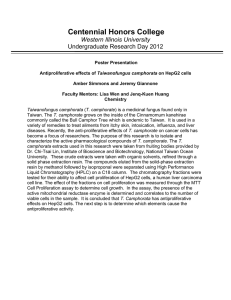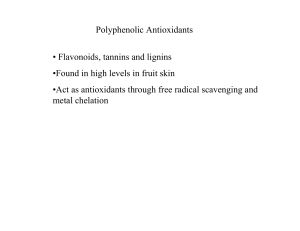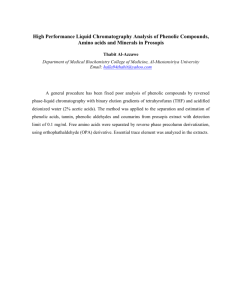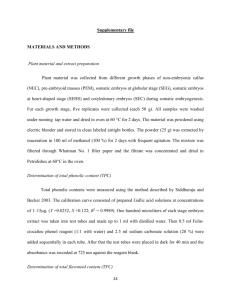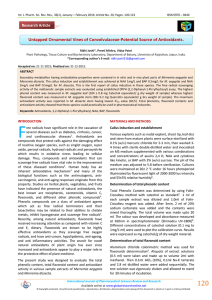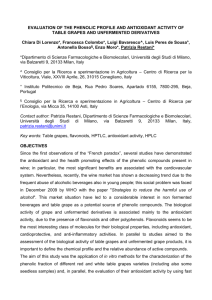Document 14258075
advertisement
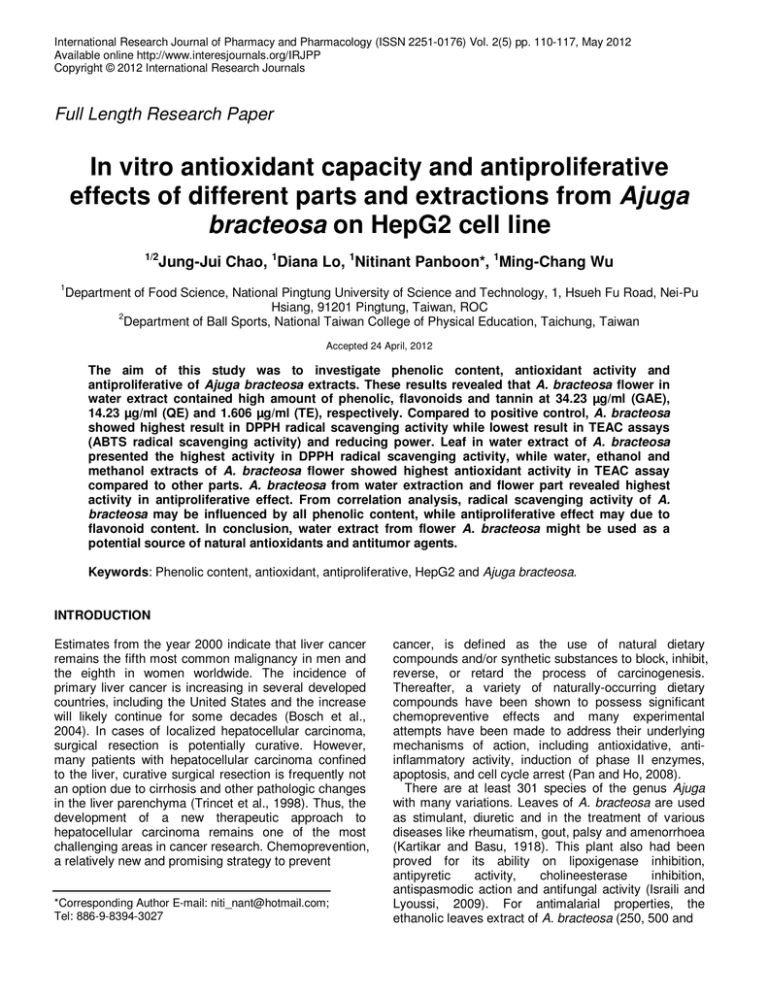
International Research Journal of Pharmacy and Pharmacology (ISSN 2251-0176) Vol. 2(5) pp. 110-117, May 2012
Available online http://www.interesjournals.org/IRJPP
Copyright © 2012 International Research Journals
Full Length Research Paper
In vitro antioxidant capacity and antiproliferative
effects of different parts and extractions from Ajuga
bracteosa on HepG2 cell line
1/2
Jung-Jui Chao, 1Diana Lo, 1Nitinant Panboon*, 1Ming-Chang Wu
1
Department of Food Science, National Pingtung University of Science and Technology, 1, Hsueh Fu Road, Nei-Pu
Hsiang, 91201 Pingtung, Taiwan, ROC
2
Department of Ball Sports, National Taiwan College of Physical Education, Taichung, Taiwan
Accepted 24 April, 2012
The aim of this study was to investigate phenolic content, antioxidant activity and
antiproliferative of Ajuga bracteosa extracts. These results revealed that A. bracteosa flower in
water extract contained high amount of phenolic, flavonoids and tannin at 34.23 µg/ml (GAE),
14.23 µg/ml (QE) and 1.606 µg/ml (TE), respectively. Compared to positive control, A. bracteosa
showed highest result in DPPH radical scavenging activity while lowest result in TEAC assays
(ABTS radical scavenging activity) and reducing power. Leaf in water extract of A. bracteosa
presented the highest activity in DPPH radical scavenging activity, while water, ethanol and
methanol extracts of A. bracteosa flower showed highest antioxidant activity in TEAC assay
compared to other parts. A. bracteosa from water extraction and flower part revealed highest
activity in antiproliferative effect. From correlation analysis, radical scavenging activity of A.
bracteosa may be influenced by all phenolic content, while antiproliferative effect may due to
flavonoid content. In conclusion, water extract from flower A. bracteosa might be used as a
potential source of natural antioxidants and antitumor agents.
Keywords: Phenolic content, antioxidant, antiproliferative, HepG2 and Ajuga bracteosa.
INTRODUCTION
Estimates from the year 2000 indicate that liver cancer
remains the fifth most common malignancy in men and
the eighth in women worldwide. The incidence of
primary liver cancer is increasing in several developed
countries, including the United States and the increase
will likely continue for some decades (Bosch et al.,
2004). In cases of localized hepatocellular carcinoma,
surgical resection is potentially curative. However,
many patients with hepatocellular carcinoma confined
to the liver, curative surgical resection is frequently not
an option due to cirrhosis and other pathologic changes
in the liver parenchyma (Trincet et al., 1998). Thus, the
development of a new therapeutic approach to
hepatocellular carcinoma remains one of the most
challenging areas in cancer research. Chemoprevention,
a relatively new and promising strategy to prevent
*Corresponding Author E-mail: niti_nant@hotmail.com;
Tel: 886-9-8394-3027
cancer, is defined as the use of natural dietary
compounds and/or synthetic substances to block, inhibit,
reverse, or retard the process of carcinogenesis.
Thereafter, a variety of naturally-occurring dietary
compounds have been shown to possess significant
chemopreventive effects and many experimental
attempts have been made to address their underlying
mechanisms of action, including antioxidative, antiinflammatory activity, induction of phase II enzymes,
apoptosis, and cell cycle arrest (Pan and Ho, 2008).
There are at least 301 species of the genus Ajuga
with many variations. Leaves of A. bracteosa are used
as stimulant, diuretic and in the treatment of various
diseases like rheumatism, gout, palsy and amenorrhoea
(Kartikar and Basu, 1918). This plant also had been
proved for its ability on lipoxigenase inhibition,
antipyretic
activity,
cholineesterase
inhibition,
antispasmodic action and antifungal activity (Israili and
Lyoussi, 2009). For antimalarial properties, the
ethanolic leaves extract of A. bracteosa (250, 500 and
Chao et al. 111
750 mg/kg/day) demonstrated a dose-dependent
chemosuppression during early and in established
infections, along with significant (p<0.05) repository
activity (Chandel and Bagai, 2010). Interestingly,
antimalarial natural products might provide a fertile and
much needed lead in anticancer drug discovery. In total,
14 out of 15 nature-derived antimalarials (93%)
referenced by WHO as well as 146 of 235 antimalarial
natural species (62%) from medline search, including
Ajuga decumbens, were reported as having anticancer
activity (Duffy et al., 2010). Two major constituents of
Ajuga decumbens, cyasterone and 8-acetylharpagide,
have potent antitumor-promoting activities on a mouseskin in vivo two-stage carcinogenesis procedure
(Takasaki et al., 1999). There is no clinical efficacy of
Ajuga bracteosa as an antiproliferative for cancer cell.
Therefore, the present study was undertaken to
evaluate antioxidant properties and antiproliferative
effect of Ajuga bracteosa on HepG2 liver hepatocellular
carcinoma.
standard curve using gallic acid as standard. Results
were expressed as gallic acid equivalent (GAE) in
micrograms per miligram of dry residue (Hwang et al.,
2011).
Determination of total flavonoid content
Briefly, 0.5 mL aliquot of appropriately diluted sample
solution was mixed with 2 mL of distilled water and
subsequently with 0.15 mL of a 5% NaNO2 solution.
After 6 min, 0.15 mL of a 10% AlCl3 solution was added
and allowed to stand for 6 min, then 2 mL of 4% NaOH
solution was added to the mixture. Immediately, water
was added to bring the final 3 volume to 5 mL, then the
mixture was thoroughly mixed and allowed to stand for
another 15 min. Absorbance of the mixture was
determined at 510 nm versus a prepared water blank.
The total flavonoid content was determined using a
standard curve with quercetin (0–50 µg/ml). Result was
expressed as microgram of quercetin equivalents (µg
QE) per milligram dry weight sample (Zou et al., 2004).
METHODOLOGY
Preparation of plant extracts
Determination of tannins contents
Dried Ajuga bracteosa was purchased from Pingtung
city, Taiwan. Ten grams of the respective part (leaf,
flower and stem) of Ajuga bracteosa powder were
extracted with 200 ml of boiling deionizer water for 5
min under regular stirring. The heated decoction was
removed from the hot plate and allowed to infuse for
another 30 min under regular stirring. For ethanol and
methanol extractions, ten grams of the respective plant
powder was added into 200 ml of 80% ethanol or
methanol and allowed to macerate for 3 h under regular
stirring. The resulting mixture was centrifuged at 3000
rpm for 10 min (Jouan CR 412, Vel, Belgium). After
supernatant was filtered (Whatman No.1), the filtrate
was concentrated under vacuum (50°C for water extract
and 40°C for ethanol and methanol extract) and
lyophilized. Lyophilized powders were dissolved and
stored at -18°C for further use.
The presence of tannins was identified using the classic
FeCl3 and gelatin tests. Amount of 0.005 g of dry
sample was transferred to test tubes; 2.5 ml water was
added and boiled for 30 min. After filtration with cotton
filter the solution was further transferred to a 50 ml test
tubes and water was added ad 25 ml mark. 0.25 ml
aliquots were finally transferred to vials, 0.5 ml 1%
K3Fe(CN)6 and 0.5 ml 1% FeCl3 were added, and
water was added ad 5 ml volume. After five min time
period, the solutions were measured using
spectrophotometer at 720 nm. The actual tannin
concentrations were calculated on the basis of the
optical absorbance values obtained for the standard
solutions in range 5-25 µg/ml (Paaver et al., 2010).
Determination phenolic concent
Determination of total phenolic content
The Folin–Ciocalteau method was conducted for the
colorimetric estimation of total phenolic content. Each
water extract (200 µL) was oxidised with Folin–
Ciocalteau’s reagents (2 N, 200 µL) for 4 min, and then
the reaction was neutralised with saturated sodium
carbonate (75 g/L, 400 µL). The absorbance of the
resulting blue color was measured at 725 nm with an
ultraviolet– visible spectrophotometer (Shimadzu
UV2550, Kyoto, Japan) after incubation for 1 h at room
temperature. Quantification was done based on a
Antioxidant capacity
DPPH (2, 2-diphenyl-1-picrylhydrazyl)
scavenging activity assay
radical
Radical scavenging activity of plant in different
extractions and parts were determined according to Luo
et al. (2011). Different concentrations of plant powder
(100,500 and 1000 µg/ml) in ethanol (2 ml) were mixed
with 2 ml of ethanolic solution containing 1 mM DPPH.
The mixture was shaken vigorously and then left to
stand for 30 min in the dark. The absorbance was
measured at 517 nm. The control sample was also
prepared as above without any extract and ethanol was
used for the baseline correction. Radical scavenging
activity was calculated as the inhibition percentage and
was calculated using the following formula: (absorbance
112 Int. Res. J. Pharm. Pharmacol.
control-absorbance sample)/absorbance control ×
100%. Ascorbic acid, buthylated hydroxytoluene and
gallic acid were used as standards.
TEAC (Trolox Equivalent Antioxidant Capacity)
assay
The radical scavenging activity of the isolated
compounds against ABTS•+ was measured using the
methods of Han et al. (2008) with some modifications.
ABTS was dissolved in PBS (0.01 M, pH 7.4) to a 7 mM
concentration. ABTS•+ was produced by reacting ABTS
stock solution with 2.45 mM potassium persulfate (final
concentration) and allowing the mixtures to stand in the
dark at room temperature for 16 h before use. The
ABTS•+ solution was diluted with PBS (0.01 M, pH 7.4)
to an absorbance of 0.70 (±0.02) at 734 nm and
equilibrated at 30 °C for 30 min. An ethanol solution
(2.0 ml) of the samples at various concentrations (100,
500 and 1000 µg/ml) was mixed with 2.0 ml of diluted
ABTS•+ solution. After reaction at room temperature for
20 min, the absorbance at 734 nm was measured.
Lower absorbance of the reaction mixture indicates
higher ABTS•+ scavenging activity. The capability to
scavenge the ABTS•+ was calculated using the
following formula, where absorbances (blank sample) (Abs)
was absorbance of 2.0 ml of PBS plus 2 ml of the
sample at different concentrations, absorbances (control)
(Ac) was absorbance of 2.0 ml of diluted ABTS•+
solution plus 2 ml of ethanol and absorbances (blank control)
(Abc) was absorbance of 2.0 ml of PBS plus 2 ml of
ethanol. ABTS radical scavenging activity (%) was
calculated by {1-(Asample-Abs)/(Ac-Abc)}x 100%.
Reducing power assay
The reducing power of the samples is determined
according to the method described by Zou et al. (2004).
One ml of different concentration sample (100, 500 and
1000 µg/ml) in methanol is mixed with 0.2 M phosphate
buffer (2.5 ml, pH 6.6) and 1% potassium ferricyanide
(2.5 ml), and the mixture is incubated at 50°C for 20 min.
Afterward, 2.5 ml of 10% trichloroacetic acid are added
to the reaction mixture and centrifuged at 3000 rpm for
10 min. The upper layer of the solution (2.5 ml) is mixed
with 2.5 ml distilled water and 1 ml of 1% ferric chloride.
The absorbance is measured at 700 nm. A higher
absorbance of this mixture indicates a higher reducing
activity. Ascorbic acid, buthylated hydroxytoluene and
gallic acid were used as standards.
Cell culture
Cancer cell lines, including HepG2, a human
hepatocarcinoma cell line, were obtained from reseach
center in Hsinchu. The cell lines were cultured in
Dulbecco’s modified Eagle’s medium (DMEM)
containing 10% (v/v) heat-inactivated fetal bovine
serum (FBS) and 0.05% of penicillin. Cells were
maintained in a humidified incubator at 37 °C in a 5%
CO2 atmosphere (Kim et al., 2010). The effect of the
extracts on the cell viability of various cancer cell lines
was determined by the 3-(4, 5-dimethylthiazol-2-yl)-2,5diphenyltetrazolium bromide (MTT) colorimetric assay.
Briefly, exponential-phase cells were collected and
5
transferred to a 96-well plate (1×10 cells per well). The
cells were then incubated for 24 h in the presence of
various concentrations of the extracts. After incubation,
0.1 mg of MTT was added to each well and the cells
were incubated at 37°C for 4 h. The media was then
carefully removed and DMSO (100 µl) were added to
each well to dissolve the formazan crystals. The plates
were read after 10 min at 570 nm on a microplate
reader.
Statistical analysis
Experiments were done in three replication and the data
were expressed as mean ± standard deviation (SD).
Statistical analysis were performed by SPSS analysis of
variance with Duncan’s post hoc where p<0.05 (p<0.01
for antiproliferative assay) indicated that the results
have statistically significant differences. Graphics
shown were made by SigmaPlot 10.0 graphics software.
RESULTS
Phenolic content of Ajuga bracteosa
Determined phenolic contents are including total
phenolic content, total flavonoid and total tannin. The
revealed results in Table 1 showed that flower part of A.
bracteosa in water extract contained highest amount of
phenolic, flavonoids and tannin at 34.23 µg GAE /mg,
14.28 µg QE/mg and 8.04 µg TAE /mg, respectively.
Lowest phenolic and flavonoid content found in A.
bracteosa stem part of water (11.59 µg GAE /mg) and
ethanol (0.65 µg QE/mg) extracts.
Antioxidant capacity of Ajuga bracteosa
Antioxidant capacity results were shown in Figure 1-3.
Antioxidant activity of A. bracteosa extracts are mostly
related to its ability in DPPH radical scavenging
because it showed highest result. Compared to positive
control, TEAC assay (ABTS radical scavenging activity)
and reducing power of A. bracteosa showed low
antioxidant capacity. Leaf in water extract of A.
bracteosa presented the highest activity in DPPH
radical scavenging activity (Figure 1), while water,
Chao et al. 113
Table 1. Total phenolic, flavonoid and tannin content of Ajuga bracteosa extracts in different
parts and solvent extractions.
Extract
Water
Ethanol
Methanol
Plant part
Total phenolic content
(µg GAE/mg)
Leaf
Flower
Stem
Leaf
Flower
Stem
Leaf
Flower
Stem
21.17±0.97
e
35.27 ± 1.47
a
11.59 ± 0.06
b,c
18.87 ± 1.27
d
26.96 ± 0.38
a
13.60 ± 0.93
b
17.13 ± 1.56
d
24.96 ± 1.64
13.99 ± 0.54a
c
Total
flavonoid
content (µg QE/mg)
e
7.25 ± 0.05
g
14.28 ± 0.26
f
9.52 ± 0.44
b
1.67 ± 0.10
d
2.80 ± 0.18
a
0.65 ± 0.04
c
2.18 ± 0.09
d
3.22 ± 0.18
0.95 ± 0.07a
Total tannin
(µg TAE/mg)
b
6.60 ± 0.04
f
8.04 ± 0.03
d
7.32 ± 0.07
c
6.86 ± 0.04
e
7.67 ± 0.02
a
6.44 ± 0.08
c
6.95 ± 0.10
f
8.00 ± 0.03
6.70 ± 0.05b
a-g
Data with different superscripts are significantly different at P<0.05 (n=3) analyzed by ANOVA
with Duncan’s post hoc using SPSS 13.
Table 2. Correlation coefficients of phenolic, antioxidant and HepG2 antiproliferative effect
Phenolic
Flavonoid
Tannin
DPPH
TEAC
Reducing
HepG2
Phenolic
1
Flavonoid
.518(*)
1
Tannin
.739(**)
.513(*)
1
DPPH
.600(**)
.474(*)
.075
1
TEAC
.595(**)
.700(**)
.800(**)
.351
1
Reducing
.235
-.405
-.134
.331
-.274
1
HepG2
-.330
-.521(*)
-.268
-.332
-.395
.225
1
* Correlation is significant at the 0.05 level (2-tailed).
** Correlation is significant at the 0.01 level (2-tailed).
ethanol and methanol extracts of A. bracteosa flower
showed highest antioxidant activity in TEAC assay
compared to other parts (Figure 2). In addition, all
extracts of A. bracteosa flower also revealed highest
antioxidant activity in reducing power assay compared
to others (Figure 3).
Antiproliferative effect of Ajuga bracteosa on
HepG2 cell line
Antiproliferation activities were also studied in vitro
using HepG2 human liver hepatocellular carcinoma, and
A. bracteosa flower extract revealed highest activity. In
the concentration of 125 µg/mL, all the extract showed
significant antiproliferative activity compared to negative
control. Positive control used in this research are 5Flourouracil (100 µg/mL), and water extract of leaf,
flower and stem in the concentration of 500 µg/mL
showed highest antiproliferative activity and they have
no significant difference to positive control.
Correlation coefficients of phenolic, antioxidant and
HepG2 antiproliferative effect
Correlation coefficients of phenolic, antioxidant and
HepG2 antiproliferative effect result are shown in Table
2. Result showed that DPPH and TEAC assays closely
related to total phenolic content (p<0.01). Total
flavonoid and tannin content also closely related with
ABTS radical scavenging activity, which mean that all of
total phenolic, flavonoid and tannin contents contribute
to radical scavenging activity but not for reducing power.
On the other hand, HepG2 antiproliferative activity has
correlation with total flavonoid content in the lower
significance (p<0.05).
DISCUSSION
Phenolic compounds are attracting considerable
interest in food and medicine area due to its antioxidant
capacity. Antioxidants may act in various ways such as
114 Int. Res. J. Pharm. Pharmacol.
Figure 1. DPPH radical scavenging activities of Ajuga bracteosa water extract (a), ethanol
extract (b), methanol extract (c) and positive control (d). a-fData with different superscripts are
significantly different at P<0.05 (n=3) analyzed by ANOVA with Duncan’s post hoc using
SPSS 13.
Figure 2. TEAC (Trolox Equivalent Antioxidant Capacity) assay of Ajuga bracteosa water extract (a),
ethanol extract (b), methanol extract (c) and positive control (d). a-kData with different superscripts
are significantly different at P<0.05 (n=3) analyzed by ANOVA with Duncan’s post hoc using SPSS
13.
Chao et al. 115
Figure 3. Reducing powers of Ajuga bracteosa water extract (a), ethanol extract (b), methanol
extract (c) and positive control (d). a-eData with different superscripts are significantly different at
P<0.05 (n=3) analyzed by ANOVA with Duncan’s post hoc using SPSS 13.
Figure 4. Antiproliferative activity of Ajuga bracteosa water extract (a), ethanol extract (b), methanol extract
(c) on HepG2 liver hepatocellular carcinoma. a-dData with different superscripts are significantly different at
P<0.05 (n=3) analyzed by ANOVA with Duncan’s post hoc using SPSS 13.
116 Int. Res. J. Pharm. Pharmacol.
scavenging the radicals, decomposing the peroxides
and chelating the metal ions. Plant polyphenols are
multifunctional and can act as reducing agents,
hydrogen donating antioxidants, singlet oxygen
quenchers and also metal chelation in same case
(Rice-Evans et al., 1996). The result of this present
study indicated that phenolic compounds of A.
bracteosa are powerful free radical scavenger of DPPH
radical. Rice-Evans et al. (1997) has reported that
antioxidant properties of phenolic compound relative to
Trolox, the water-soluble vitamin E analogue, are
related to their structures. The structural arrangements
imparting greatest antioxidant activity as determined
from these studies are: (1) the ortho 3',4'-dihydroxy
moiety in the B ring (e.g. in catechin, luteolin and
quercetin); (2) the meta 5,7-dihydroxy arrangements in
the A ring (e.g. in kaempferol, apigenin and chrysin); (3)
the 2,3-double bond in combination with both the 4-keto
group and the 3-hydroxyl group in the C ring, for
electron delocalization (e.g. in quercetin), as long as the
o-dihydroxy structure in the B ring is also present.
However, alterations in the arrangement of the hydroxyl
groups and substitution of contributing hydroxyl groups
by glycosylation decrease the antioxidant activity (RiceEvans et al., 1997). In addition, Hagerman et al. (1998)
reported that the high molecular weight phenolics
(tannins) have more ability to quench free radicals
(ABTS +) and that effectiveness depends on the
molecular weight, the number of aromatic rings and
nature of hydroxyl groups’ substitution than the specific
functional groups.
Cancer chemoprevention is currently regarded as
promising way for cancer control. The polyphenolic
components of higher plants may act as antioxidants or
as agents of other mechanisms contributing to
anticarcinogenic or cardioprotective action (Rice-Evans
et al., 1996). Moderate correlation was observed
between antiproliferative effect and total flavonoid
content. Great interest has been paid to flavonoids-one
of the major classes of natural products with
widespread distribution in fruits, vegetables, spices, tea
and
soy-based
foodstuff-for
their
interesting
antiproliferative activities. From its structure–activity
relationships, 2′-hydroxychalcones and methoxylated
flavanones were found to be potent inhibitors of MCF-7
breast cancer cells growth (Pouget et al., 2001).
eside of phenolic compound, Ajuga bracteosa also
contains terpenoids and steroids. Withanolides
(bracteosin
A,
B,
C),
β-sitosterol
3-O-β-Dglucopyranoside, dihydroclerodin-1, cleronidin A,
dihydroajugapitin and lupulin A have been isolated from
this plant (Riaz, 2004). Other compound such as
hexacosanol, tetracosanoic acid (Bhakuni et al., 1978)
and betulinic acid (Arfan et al., 1996) also found in A.
bracteosa. Ichikawa et al. (2006) found that
withanolides, biologically active natural steroidal
lactones, suppressed NF-κB activation induced by a
variety of inflammatory and carcinogenic agents,
including tumor necrosis factor (TNF), interleukin-1B,
doxorubicin, and cigarette smoke condensate.
Suppression was not cell type specific, as both
inducible and constitutive NF-κB activation was blocked
by withanolides (Ichikawa et al., 2006). In summary, the
results of this study indicate that water extract of A.
bracteosa flower may be considered as good source of
natural compounds with significant free radical
scavenging and antiproliferative effect and it may due to
its phenolic compound.
REFERENCES
Arfan M, Khan GA, Ahmad N (1996). Steroids and terpenoids of the
Genus Ajuga. J. Chem. Soc. Pak. 18(2): 170-174.
Bhakuni RS, Shukla YN, Thakur RS (1978). Chemical Constituents of
Ajuga bracteosa. Indian J. Pharm. Sci. 49(6): 225-226.
Bosch FX, Ribes J, Díaz M, Cléries R (2004). Primary liver cancer:
Worldwide incidence and trends. Gastroenterology 127(5:1): S5–
S16.
Chandel S, Bagai U (2010). Antiplasmodial activity of Ajuga bracteosa
against Plasmodium berghei infected BALB/c mice. Indian J. Med.
Res. 131: 440-444.
Duffy R, Wade C, Chang R (2010). Discovery of anticancer drugs
from antimalarial natural products: a MEDLINE literature review.
Drug Discovery Today 1-11.
Hagerman AE, Riedl KM, Jones GA, Sovik KN, Ritchard NT, Hartzfeld
PW, Riechel TL (1998). High molecular weight plant polyphenolics
(Tannins) as biological antioxidants. J. Agric. Food Chem. 46:
1887-1892.
Han J, Weng X, Bi K (2008). Antioxidants from a Chinese medicinal
herb- Lithospermum erythrorhizon. Food Chem. 106: 2-10.
Hwang KA, Hwang YJ, Park DS, Kim J, Om AS (2011). In vitro
investigation of antioxidant and anti-apoptotic activities of Korean
wild edible vegetable extracts and their correlation with apoptotic
gene expression in HepG2 cells. Food Chem. 125: 483-487.
Ichikawa H, Takada Y, Shishodia S, Jayaprakasam B, Nair MG,
Aggarwal BB (2006). Withanolides potentiate apoptosis, inhibit
invasion, and abolish osteoclastogenesis through suppression of
nuclear factor-KB (NF-KB) activation and NF-KB–regulated gene
expression. Mol. Cancer Ther. 5: 1434-1445.
Israili ZH, Lyoussi B (2009). Ethnopharmacology of the plants of
genus Ajuga. Pak. J. Pharm. Sci. 22(4): 425-462.
Kirtikar KR, Basu BD (1918). Indian Medicinal Plants. Indian Press,
Allahabad.
Luo W, Zhao M, Yang B, Ren J, Shen G, Rao G (2011). Antioxidant
and antiproliferative capacities of phenolics purified from
Phyllanthus emblica L. fruit. Food Chem. 126: 277–282.
Paaver U, Matto V, Raal A (2010). Total tannin content in distinct
Quercus robur L. galls. Journal of Medicinal Plants Research 4(8):
702-705.
Pan MH, Ho CT (2008). Chemopreventive effects of natural dietary
compounds on cancer development. Chem. Soc. Rev. 37: 2558–
2574.
Pouget C, Lauthier F, Simon A, Fagnere C, Basly JP, Delage C,
Chulia AJ (2001). Flavonoids: structural requirements for
antiproliferative activity on breast cancer cells. Bioorg. Med.Chem.
Lett. 11(24): 3095-3097.
Riaz N (2004). Phytochemical investigation on the chemical
constituents of Paeonia emodi Wall, Alysicarpus monolifer Linn.
and Ajuga bracteosa Wall. University of Karachi, Sindh.
Rice-Evans CA, Miller NJ, Paganga G (1996). Structure-antioxidant
activity relationships of flavonoids and phenolic acids. Free Radical
Biol. Med. 20(7): 933-956.
Rice-Evans CA, Miller NJ, Paganga G (1997). Antioxidant properties
of phenolic compounds. Trends in Plant Sci. 2(4): 152-159.
Takasaki M, Tokuda H, Nishino H, Konoshima T (1999). Cancer
chemopreventive agents (antitumor-promoters) from Ajuga
decumbens. J. Nat. Prod. 62(7): 972-975.
Trinchet JC, Ganne-Carrie N, Beaugrand M (1998). Intra-arterial
chemoembolization in patients with hepatocellular carcinoma.
Chao et al. 117
Hepatogastroenterology 45: 1242-1247.
Zou Y, Lu Y, Wei D (2004). Antioxidant activity of a flavonoid-rich
extract of Hypericum perforatum L. in vitro. J. Agric. Food Chem.
52: 5032-5039.
